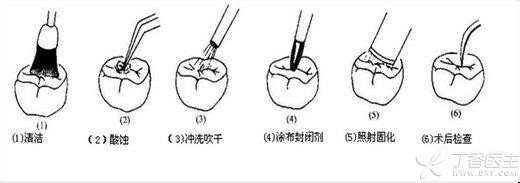
I often encounter such a phenomenon in my usual work:
Children aged 3-5 came to examine their teeth and found more than 10 decayed teeth, and 8 large teeth were completely wiped out from top to bottom, left and right.
So parents will ask:
When we were young, nobody cared, we didn’t brush our teeth, and our teeth didn’t break like this. Why were our babies’ teeth all eaten?
With the improvement of material living standards, the food that babies eat now is getting more and more fine. After the babies finish eating, the food is especially easy to adhere to the teeth, especially easy to remain in the grooves and seams of [big teeth], and it is not easy to be cleaned.
After that, all kinds of bacteria in the oral cavity began to be busy, decomposing the residual delicious food while [corroding] the baby’s teeth. Over time, natural tooth decay will increase.
So can parents do some what to prevent it? By the way, pit and fissure are closed. I believe many parents have heard this term at ordinary times, and then I will talk to you in detail.
Is what pit and fissure closed?
First, let’s introduce that the lower what is pit and fissure.
The occlusal surface on which the teeth at the back of each person’s mouth eat and chew is uneven and potholed, and the potholed part is called pit and fissure.
Pits and fissure are like dead corners of gaps between ceramic tiles paved on the ground. Dust and dirty things are easy to accumulate in the gaps between ceramic tiles and are not easy to clean out.
If these dead corners and gaps are sealed at the beginning of decoration, it is not easy to accumulate dust, and pit and fissure sealing is equivalent to this treatment process.
Pit and fissure sealant is to apply [pit and fissure sealant] to the pit and fissure of teeth. These materials will solidify and harden to form a protective barrier covering the pit and fissure. This barrier can prevent food residue from entering, prevent bacteria and their metabolites from eroding teeth, and does not affect occlusal function, thus achieving the effect of preventing dental caries (tooth decay).
Pit and fissure sealing is a protective measure recommended by the World Health Organization to children all over the world. It is economical and effective and can reduce the incidence of dental caries.
How old is the baby to do pit and fissure sealing?
When the tooth erupts completely, caries has not occurred, and there is no gum coverage around it, pit and fissure sealing is most suitable (usually within 4 years of tooth eruption).
The teeth that need pit and fissure sealing most are generally [deciduous molars] in deciduous teeth and [molars] in permanent teeth. The most suitable age group for pit and fissure sealing is:
- 3-4 years old: 8 deciduous molars, 6-9 years old: 4 first permanent molars (6-year-old teeth), 11-13 years old: 4 second permanent molars.
Some children are especially prone to tooth decay and oral hygiene is very poor. It is suggested that the pit and fissure of 8 premolars in permanent teeth should also be sealed, usually at the age of 10-12.
Why do deciduous teeth also need pit and fissure sealing?
Many parents will ask: [Why do deciduous teeth have to be sealed with pit and fissure because they will change teeth anyway? ]
In fact, the reason is very simple, because deciduous teeth are very important!
- 8 deciduous molars began to erupt at the age of 2 ~ 2.5, Only when they were 10 ~ 12 years old did they begin to fall off and replace them. Therefore, deciduous teeth have served in the oral cavity for more than ten years. Of course it must be protected. The primary molars assume the function of chewing food. Helps digestion, related to children’s growth and development. The existence of deciduous teeth leaves gaps for the eruption of permanent teeth and has guiding effect. If it is not well protected, it is easy to lead to irregular permanent teeth. Permanent tooth germ is located at the lower end of the root of deciduous teeth. If deciduous tooth caries is serious, it leads to root infection and is likely to affect the development of permanent teeth.

How to do pit and fissure sealing, using what materials?
First of all, the teeth that can be sealed with pit and fissure are teeth without caries, and the whole process is painless.
The operation of pit and fissure sealing takes a short time. With the cooperation of children, the average time to operate a tooth is about 6 minutes. The process is shown in the following figure:

Parents can rest assured that the materials that can enter the oral cavity are absolutely safe and non-toxic, so there is no need to worry about any adverse effects on children.
The material used for pit and fissure sealing is called pit and fissure sealant for short. It is an organic polymer resin material. According to the curing method, it can be divided into light curing and self-curing. The materials are imported and domestic. Their properties (such as compressive strength, wear resistance) and operation steps will be different.
In order to distinguish pit and fissure sealant from normal tooth tissue, the common colors of cured sealant are white, red, green, pink, etc.
Pay attention to what after pit and fissure sealing?
Step 1: Diet
With the sealant of light curing material, you can eat normally on the same day.
Use self-curing sealant, fast within 2 hours after finishing, and do not eat food that is too hard or sticky within 24 hours.
2. See a doctor in time when falling off.
After pit and fissure is sealed, there is a certain rate of falling off. Some children have too much saliva during operation, which may make the coating unstable and easy to fall off.
The loss rate of permanent teeth pit and fissure sealant should be low, because the children of deciduous teeth are young and have poor coordination degree, and the structural particularity of deciduous teeth causes the adhesion of materials to be lower than that of permanent teeth. If parents find that the sealant falls off, they should return to the clinic in time and re-seal it.
3. Periodic review
Generally, regular inspection should be carried out within 3-6 months after completion.
In addition, many schools will organize pit and fissure sealing, which is basically for six-year-old teeth, and regular follow-up visits are also required.
Step 4 Clean your teeth carefully
Brush your teeth carefully
- It is necessary to brush your teeth twice in the morning and evening for more than 3 minutes each time. After brushing your teeth at night, you can no longer eat (or drink milk). Use fluoride toothpaste to brush your teeth. Children’s own oral cleaning ability is limited and they need parents’ supervision and help. (In the United States, parents usually supervise their children to brush their teeth until they are 10 years old)
Floss
Because toothbrushes are difficult to clean the gaps between teeth, children should be taught to floss to ensure that each gap is passed at night (when the child is young, parents should do it for him).
5. Do Oral Health Care Well
- Periodic fluoride coating
Children who are prone to tooth decay are advised to apply fluoride once every 3 months, while children who do not have tooth decay can apply fluoride once every 6 months.
- Reasonable diet is not picky about food.
Reduce the frequency of snacks for children and gargle after eating sticky foods such as cakes and chocolates.
- Regular visits to the dentist
Go to the hospital or clinic for examination every 3 months, and find out and solve any problems as early as possible. Don’t wait until it is too late to mend the fold after the sheep is lost.
Finally, I wish every child great teeth, brilliant grin and healthy growth!
